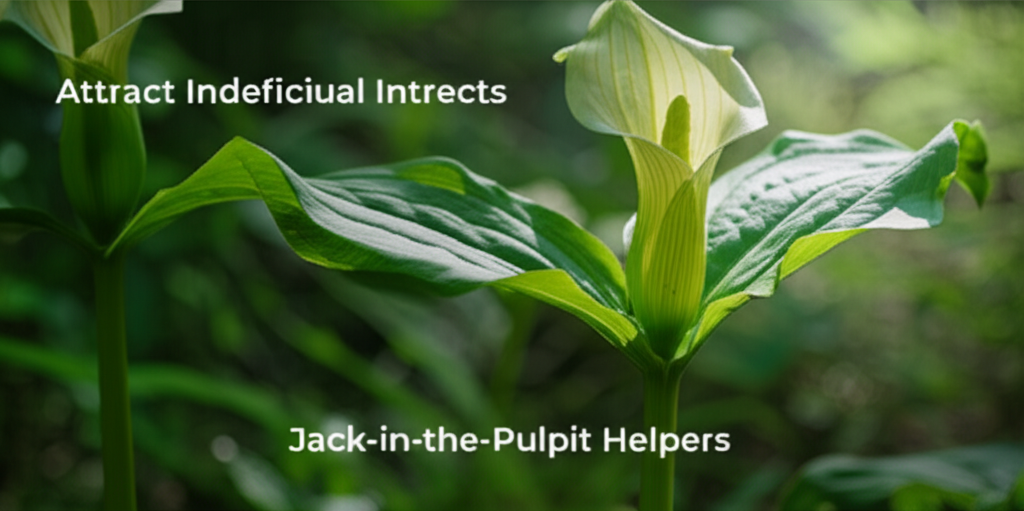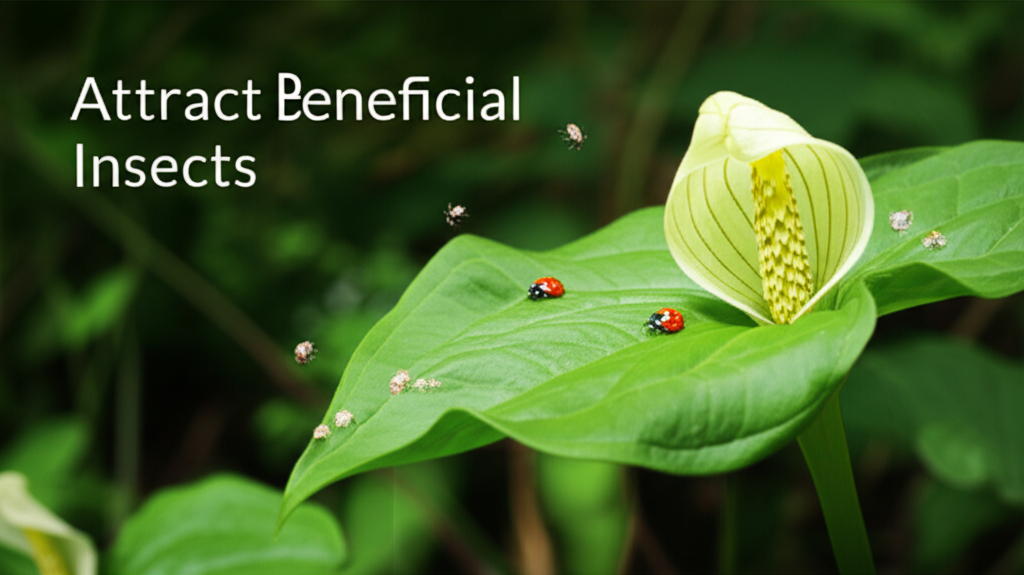The Enigmatic Jack-in-the-Pulpit: More Than Just a Pretty Face

The Jack-in-the-Pulpit (Arisaema triphyllum) is a fascinating woodland native, instantly recognizable by its unique hooded spathe that encloses the spadix, resembling a preacher in a pulpit. While its striking appearance draws admiration from gardeners and nature enthusiasts alike, its ecological role is often underestimated. Beyond its visual appeal, this plant serves as a valuable component in a healthy garden ecosystem, particularly when it comes to supporting beneficial insects. These unsung heroes of the garden are crucial for pollination, pest control, and overall plant health. Understanding how to cultivate a micro-environment that encourages their presence around your Jack-in-the-Pulpit can transform your garden into a thriving, self-sustaining haven.
Why Beneficial Insects Matter in Your Garden
Beneficial insects are the natural allies of any gardener. They perform vital services that reduce the need for chemical interventions and promote a more balanced and resilient garden. These include:
- Pollination: Many beneficial insects, such as bees, butterflies, and hoverflies, are essential pollinators. They transfer pollen between flowers, enabling plants to reproduce and produce fruits and seeds. While Jack-in-the-Pulpit is primarily wind-pollinated, its flowers can still attract pollinators that will then visit other plants in its vicinity.
- Pest Control: Predatory insects like ladybugs, lacewings, and hoverfly larvae are voracious eaters of common garden pests such as aphids, mealybugs, and spider mites. By attracting these natural predators, you can significantly reduce the damage caused by these plant-damaging insects.
- Decomposition: Some insects play a role in breaking down organic matter, returning valuable nutrients to the soil.
- Biodiversity: A garden rich in beneficial insects contributes to greater biodiversity, creating a more robust and healthy ecosystem.
Understanding the Needs of Beneficial Insects
To effectively attract and retain beneficial insects, it’s crucial to understand their basic needs. These can be categorized into three main areas: food, water, and shelter.
1. Food Sources: Nectar, Pollen, and Prey
Beneficial insects have diverse dietary requirements. Many adult predatory insects, like ladybugs and lacewings, supplement their predatory diets with nectar and pollen from flowering plants. This provides them with energy and essential nutrients.
Nectar and Pollen-Rich Plants
While Jack-in-the-Pulpit itself is not a primary nectar source for most pollinators, its presence in a woodland understory setting often means it shares space with plants that are. To truly create a beneficial insect magnet, consider companion planting. Plants that offer abundant nectar and pollen include:
- Herbs: Many common culinary herbs, when allowed to flower, become magnets for beneficial insects. Examples include dill, parsley, cilantro, fennel, and borage. Their small, clustered flowers are ideal for insects with short mouthparts.
- Wildflowers: Native wildflowers are often the best choice as they are best suited to your local climate and attract native insect species. Think coneflowers (Echinacea), sunflowers, asters, and goldenrods.
- Daisies and Composites: Plants in the Asteraceae family, such as daisies, asters, and coreopsis, provide flat-topped flower heads that offer easy access to pollen and nectar.
Prey Availability
For predatory insects, the presence of their prey is a critical food source. Healthy plant growth, including that of your Jack-in-the-Pulpit, provides habitat and food for various herbivores, which in turn sustain the predators. Encouraging a diverse range of plants will naturally lead to a more diverse insect population, both prey and predator.
2. Water Sources: Tiny Thirst Quenchers
Just like any living organism, beneficial insects need access to water. This can be challenging in a garden setting, especially during dry periods.
Creating Miniature Water Features
You don’t need a grand pond to provide water. Simple solutions can be highly effective:
- Shallow Dishes: Place a shallow dish filled with pebbles or marbles and water in your garden. The pebbles provide landing spots for insects, preventing them from drowning.
- Damp Areas: Regularly misting foliage or creating consistently damp patches of soil can offer a water source.
- Dew Collection: In the early morning, dew can provide a vital water source for many insects. Healthy foliage helps in dew formation.
3. Shelter and Habitat: Safe Havens
Beneficial insects require safe places to rest, overwinter, and lay their eggs. This includes protection from harsh weather and predators.
Providing Diverse Habitats
Consider incorporating a variety of natural elements into your garden design:
- Leaf Litter: Leave some natural leaf litter in your garden beds. This provides shelter for ground-dwelling insects and overwintering sites for many species.
- Woody Debris: Small piles of twigs, logs, or brush can offer excellent habitat for a variety of insects, including solitary bees.
- Native Plants: A diverse planting of native plants provides varied structural habitats, from low-lying ground cover to taller shrubs and trees.
- Undisturbed Areas: Designate a small, undisturbed corner of your garden where insects can safely reproduce and overwinter without disruption.
Jack-in-the-Pulpit and Its Role in Supporting Beneficial Insects
While Jack-in-the-Pulpit isn’t a powerhouse for attracting pollinators directly, its ecological niche in the garden can be leveraged to benefit insects.
Understanding Jack-in-the-Pulpit’s Habitat Needs
Jack-in-the-Pulpit thrives in moist, shady to partially shaded woodland environments. It prefers rich, organic soil. This means that the conditions ideal for Jack-in-the-Pulpit are often also ideal for a variety of beneficial insects.
Synergy with Companion Plants
The key to maximizing beneficial insect attraction around your Jack-in-the-Pulpit lies in strategic companion planting. By surrounding your Jack-in-the-Pulpit with plants that provide the food, water, and shelter needs of beneficial insects, you create a micro-ecosystem where both the Jack-in-the-Pulpit and its insect allies can flourish.
Key Plant Characteristics for Companion Planting
When selecting companion plants, consider these features:
- Bloom Time: Choose plants that bloom at different times throughout the season to provide a continuous food source.
- Flower Shape: A variety of flower shapes will attract a wider range of insects. Small, clustered flowers are great for tiny beneficials, while larger, open flowers can accommodate bees and butterflies.
- Native Status: Prioritizing native plants is crucial for supporting native insect populations.
- Growth Habit: A mix of groundcovers, mid-height plants, and taller flowering species will offer diverse habitats.
Practical Steps to Attract Beneficial Insects to Your Jack-in-the-Pulpit Garden
Implementing these strategies will transform your Jack-in-the-Pulpit patch into a thriving insect habitat.
Step-by-Step Implementation
- Assess Your Garden Conditions: Determine the amount of shade, moisture levels, and soil type in the area where your Jack-in-the-Pulpit is planted.
- Select Companion Plants: Choose a variety of flowering plants that meet the needs of beneficial insects and are suitable for your garden’s conditions. Focus on native species.
- Incorporate Water Features: Install a shallow dish with pebbles and water or ensure regular misting of foliage.
- Provide Shelter: Leave leaf litter, introduce small brush piles, or consider installing insect hotels.
- Avoid Pesticides: This is paramount. Even organic pesticides can harm beneficial insects. Embrace natural pest control methods.
- Embrace Imperfection: A perfectly manicured garden is not ideal for beneficial insects. Allow some plants to go to seed, leave some stems standing over winter, and embrace a slightly wilder aesthetic.
- Observe and Adapt: Pay attention to which insects visit your garden and which plants they are attracted to. Adjust your planting plan accordingly in subsequent seasons.
Key Facts and Comparisons: Beneficial Insects and Their Host Plants
Here’s a look at some common beneficial insects and the types of plants that attract them. This table can help in selecting companion plants for your Jack-in-the-Pulpit garden.
| Beneficial Insect | Primary Food Source (Adults) | Ideal Flower Characteristics | Plants that Attract Them |
|---|---|---|---|
| Ladybugs | Aphids, Scale Insects, Mealybugs (larvae & adults); Nectar & Pollen (adults) | Small, clustered flowers; flat-topped flower heads | Dill, Fennel, Parsley, Yarrow, Coreopsis, Asters |
| Lacewings | Aphids, Mealybugs, Spider Mites, Thrips (larvae); Nectar, Pollen, Honeydew (adults) | Small flowers, often with a sweet fragrance | Dill, Cilantro, Sweet Alyssum, Cosmos, Marigolds |
| Hoverflies (Syrphid Flies) | Aphids, small caterpillars (larvae); Nectar & Pollen (adults) | Small, open flowers; umbelliferous flowers | Dill, Fennel, Parsley, Queen Anne’s Lace, Aster family |
| Braconid Wasps | Caterpillars, Aphids, other insect larvae (parasitize hosts) | Small flowers; often attracted to plants that host their prey | Yarrow, Fennel, Dill, Coriander, Comfrey |
| Minute Pirate Bugs | Thrips, small caterpillars, mites, insect eggs (feed on various small insects) | Small, accessible flowers | Many flowering plants, especially those with small blooms |
Pros and Cons of Attracting Beneficial Insects
While the benefits are significant, it’s helpful to consider the practical implications of cultivating a beneficial insect-friendly garden.
Steps, Pros, and Cons of Attracting Beneficial Insects
| Aspect | Description | Pros | Cons |
|---|---|---|---|
| Planting Strategy | Incorporating a diverse range of nectar and pollen-rich plants, especially natives, around Jack-in-the-Pulpit. | Provides continuous food sources, supports native insect populations, enhances garden aesthetics. | Requires careful plant selection and planning; some plants may require specific growing conditions. |
| Water Provision | Creating shallow water sources like pebble dishes or regular misting. | Essential for insect survival, especially during dry periods; easy to implement. | Requires regular maintenance to keep clean and filled; can attract mosquitoes if not managed properly (use moving water or small water sources). |
| Habitat Creation | Leaving leaf litter, providing brush piles, or installing insect hotels. | Offers crucial shelter, overwintering sites, and breeding grounds for beneficial insects. | May require a slight shift in gardening aesthetics (e.g., less tidiness); some homeowners might find it less appealing. |
| Pesticide Avoidance | Eliminating or significantly reducing the use of all pesticides. | Protects beneficial insects, leading to natural pest control; creates a healthier ecosystem. | May require patience as natural pest control mechanisms establish; occasional outbreaks of pests might occur before predators catch up. |
| Overall Garden Health | A garden rich in beneficial insects. | Reduced pest damage, improved pollination, increased biodiversity, a more resilient and self-sustaining garden. | Requires a commitment to natural gardening practices; initial investment in time and potentially plants. |
Beyond Jack-in-the-Pulpit: Creating a Whole Garden Ecosystem
While focusing on attracting beneficial insects to your Jack-in-the-Pulpit patch is a great start, remember that a truly thriving ecosystem benefits from a holistic approach. Consider how your entire garden can become a welcoming habitat.
Expanding the Beneficial Insect Haven
- Varying Plant Heights and Structures: From groundcovers to shrubs and trees, diverse plant structures offer a wider range of habitats for different insect species.
- Successional Blooming: Ensure there’s always something in bloom from early spring to late fall.
- Native Grasses: Many native grasses provide shelter and food for various insects, including butterflies and moths.
- Compost Piles: A well-managed compost pile can be a haven for many beneficial invertebrates.
Conclusion: Cultivating a Symbiotic Relationship
Your Jack-in-the-Pulpit is more than just an ornamental plant; it’s a potential cornerstone of a vibrant, ecologically balanced garden. By understanding the fundamental needs of beneficial insects – food, water, and shelter – and by strategically integrating companion plants and habitat features around your Jack-in-the-Pulpit, you can cultivate a garden that buzzes with life. This symbiotic relationship not only benefits your plants by providing natural pest control and pollination but also contributes to the broader health of your local environment. Embrace a more natural approach to gardening, and watch your Jack-in-the-Pulpit patch transform into a miniature ecosystem teeming with the essential allies that make a garden truly flourish.


